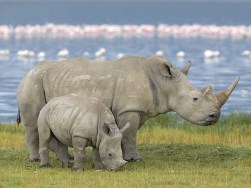By Sarah Burke, Greener Ideal
It’s a devastating year for rhinos.
As of this month, the official figures from the South African Government have surpassed its highest figure to date, that of 1,004 in 2013.
The figures have been looming since July, when the number of animals killed was already 100 higher than at the same point in 2013. However, as of November, 1,020 animals have been killed.

In the 15 years between 1990 and 2005, poachers in South Africa killed an average of 14 rhinos a year. In 2010, 333 rhinos were poached. In 2011, it was 448. In 2012, it was 668.
It was a crisis last year at 1,004 – there are no words for what this is.
It has been the large, tourist-filled Kruger National Park that has been hit the hardest by these devastating deaths.
“Since January 2014, 351 rhinos have been poached in the park,” the department of environmental affairs said.
South Africa is home to around 25,000 rhinos, which is 80% of the world’s entire rhino population. The alarming rise in poaching figures has meant that the already endangered rhino is becoming threatened into extinction.
It’s said that the rise in poaching has been due to more sophisticated poachers who are using semi-automatic rifles or poisoned darts before hacking off their horns. Moreover, helicopters, high-powered rifles, tranquilizer guns, veterinary drugs and night vision goggles have all been use also.
In Asia, these horns are prized due to a false belief that they hold medicinal properties to cure anything from hangovers to cancer. They have also become somewhat of a status for the young and wealthy, who sprinkle Rhino horn powder into their drinks as they believe it can increase their sexual performance, with little thought of the thousands of innocent deaths that have occurred thousands of miles away.
“Rhino horn is fetching the highest prices I’ve ever seen in my career,” Tom Milliken, east and southern Africa director of the wildlife trade monitoring network Traffic.
In a 2012 Traffic report, Milliken and his co-author Jo Shaw write:
“Belief in rhino horn’s detoxification properties, especially following excessive intake of alcohol, rich food and ‘the good life’, has given rise to an affluent group of habitual users, who routinely mix rhino horn powder with water or alcohol as a general health and hangover-curing tonic,” the report said. “There is a strong, socially bonding element to such consumption which typically unfolds at group functions, including so-called ‘rhino wine associations’ in which other Asian expatriate business elites participate.”
Recent efforts have been made to halt the rise in poaching, with 96 low-level poachers being arrested in the first four months of 2014. However, there have been several cases where rangers assigned to guard reserves have been found aiding poachers, and other officials are believed to be implicated in poaching rings.
Most recently, celebrities have lent their support for the cause. In the summer, Prince William, David Beckham and Yao Ming teamed up with WildAid to create a series of public service announcements, which you can see here:
The trend in rhino poaching is disturbing, but by raising awareness of the issues at hand, hopefully we can see the trend taking a turn for the better in the coming months and years.


